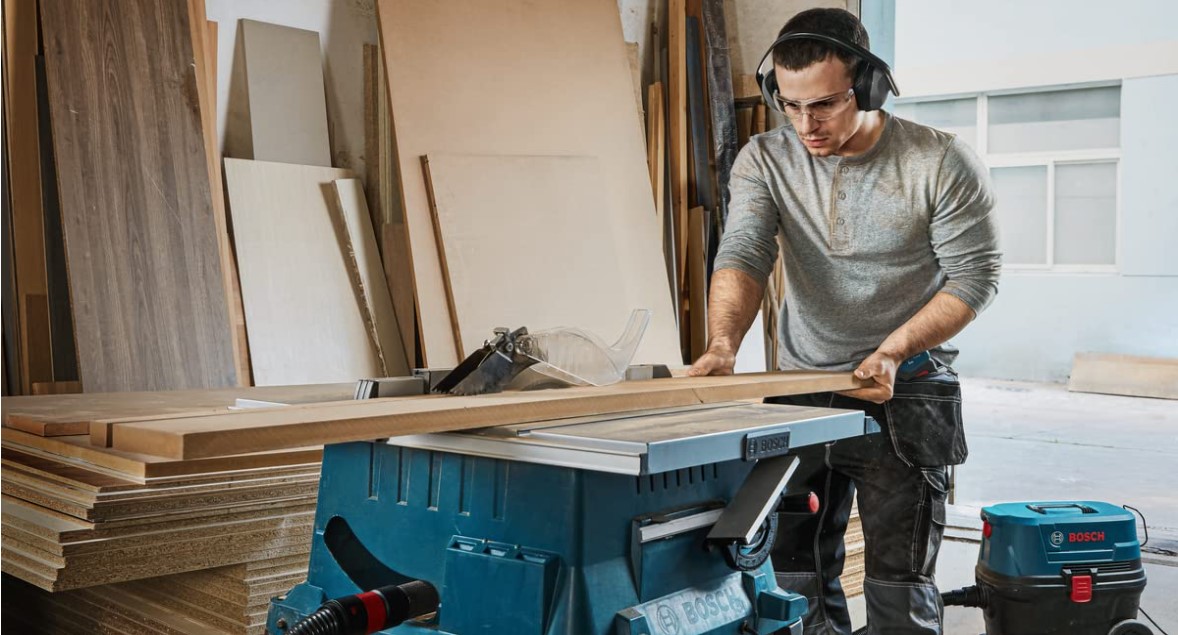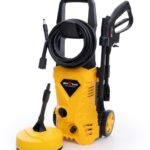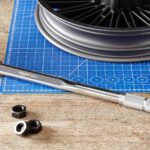A table saw is a powerful woodworking tool used to cut and shape wood, plywood, and other materials. It consists of a circular saw blade that protrudes through a flat surface or table, allowing the user to push the material across the blade for precise cuts.
The main components of a table saw include:
- Saw Blade: The circular blade is the heart of the table saw, responsible for cutting through the material. Blades come in various sizes, tooth configurations, and materials to suit different cutting applications.
- Table: The flat surface on which the material rests during cutting. The table typically has miter gauge slots and a rip fence guide to ensure accurate cuts.
- Rip Fence: An adjustable guide that runs parallel to the saw blade, allowing for straight rip cuts along the length of the material.
- Miter Gauge: A guide that slides in the miter gauge slots, enabling cross-cuts and angled cuts.
- Blade Guard and Splitter: Safety components that cover the exposed portion of the blade and prevent kickback by keeping the material from pinching the blade.
There are several types of table saws available, including:
- Contractor Table Saws: Designed for job sites and workshops, these saws are portable and have a lightweight design with wheels for easy transportation.
- Cabinet Table Saws: Stationary and robust, cabinet saws are designed for professional woodworkers and feature a heavy-duty cast iron table and powerful motors.
- Hybrid Table Saws: Combining features of contractor and cabinet saws, hybrids offer a balance of power, precision, and portability.
- Jobsite Table Saws: Compact and lightweight, these saws are designed for easy transport and use on job sites, often with folding stands or wheels.
Table saws are versatile tools capable of performing a wide range of cuts, including rip cuts, cross cuts, miter cuts, and even dado cuts with the right accessories. With proper safety precautions and technique, a table saw can be an invaluable addition to any woodworking shop.
Table of Contents
History of Table Saws
The table saw has its origins in the late 18th century, when the first crude sawmills were developed to cut lumber with circular blades powered by water wheels. These early mills were the precursors to the modern table saw, which emerged in the early 20th century as woodworking machinery became more advanced and accessible to smaller workshops and hobbyists.
One of the key innovations that led to the development of the table saw was the introduction of cast iron for the table surface. This provided a sturdy, flat surface that could support the weight of the workpiece and withstand the rigors of sawing. Additionally, the use of electric motors to power the saw blade allowed for greater precision and control compared to the earlier water or steam-powered mills.
Throughout the 20th century, table saws continued to evolve with improvements in blade design, safety features, and overall ergonomics. The introduction of riving knives, blade guards, and anti-kickback pawls helped make table saws safer to operate, while features like miter gauges, fence systems, and dust collection ports enhanced their functionality and usability.
Today’s table saws come in a variety of sizes and configurations, from compact benchtop models to large, industrial-grade cabinet saws, catering to the needs of both hobbyists and professional woodworkers. With the advent of advanced materials like carbide-tipped blades and precision-ground cast iron surfaces, modern table saws offer exceptional cutting accuracy and performance.
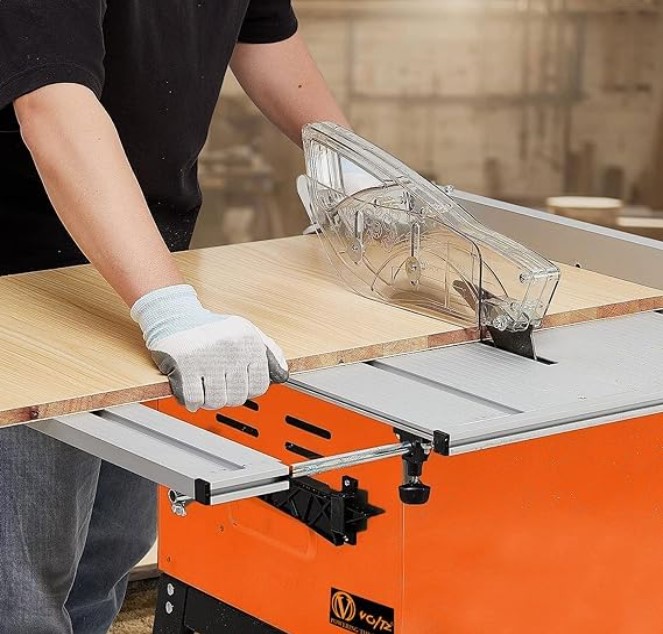
How a Table Saw Works
A table saw is a powerful woodworking tool that uses a circular blade to make precise cuts in wood and other materials. At its core, the cutting mechanism consists of a motor that spins the blade at high speeds, typically between 3,000 and 5,000 revolutions per minute (RPM).
The blade protrudes through a slot in the table, allowing the user to feed the workpiece over the blade to make cuts. The depth of the cut is controlled by adjusting the height of the blade, while the angle of the cut can be set by tilting the blade or the tabletop.
Cutting Mechanism
The cutting mechanism of a table saw is designed to provide smooth, accurate cuts while minimizing kickback and other safety hazards. The blade is mounted on an arbor, which is connected to the motor through a series of belts or gears. The arbor assembly is typically enclosed in a cast-iron or aluminum housing to protect the user from the spinning blade.
Many table saws feature a riving knife, a metal plate that sits just behind the blade. This knife helps prevent kickback by keeping the workpiece from binding against the blade and being thrown back toward the operator.
Blade Types
Table saws can accommodate a variety of blade types, each designed for specific cutting tasks. The most common blade is the combination blade, which has both flat-topped teeth for ripping (cutting along the grain) and beveled teeth for crosscutting (cutting across the grain).
Other blade types include:
- Rip blades: Designed for ripping lumber, with flat-topped teeth and a deep gullet for efficient chip removal.
- Crosscut blades: Optimized for crosscutting, with a high tooth count and beveled teeth for a smooth, clean cut.
- Dado blades: Used for cutting grooves or rabbets, these blades consist of two outer blades with a removable chipper or chipper set in between.
Safety Features
Table saws are inherently dangerous tools, and manufacturers have implemented various safety features to reduce the risk of injury. In addition to riving knives, many modern table saws include blade guards, anti-kickback pawls, and flesh-sensing technology.
Blade guards are adjustable covers that enclose the blade when not in use, protecting the operator from accidental contact. Anti-kickback pawls are spring-loaded devices that dig into the workpiece if it starts to kickback, preventing it from being thrown toward the operator.
Some high-end table saws feature flesh-sensing technology, which can detect human contact with the blade and instantly stop and retract the blade, minimizing the risk of serious injury.
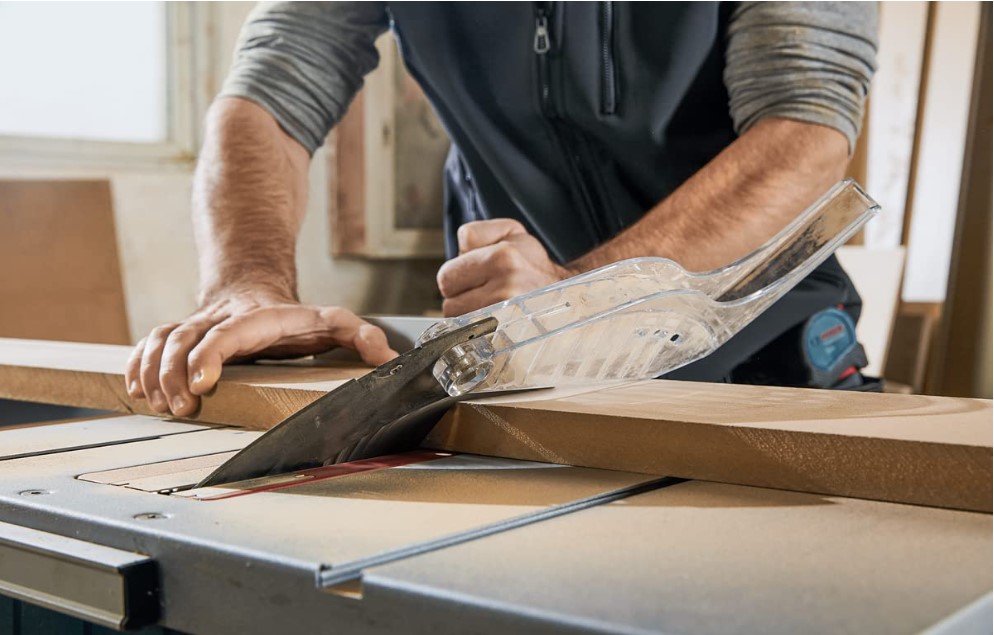
Table Saw Blades
Table saw blades are a critical component that directly impacts the performance and quality of cuts made by the saw. The blade material, size, tooth configuration, and maintenance all play a crucial role in determining the blade’s effectiveness and longevity.
Blade Materials:
Table saw blades are typically made from high-quality steel alloys, such as carbon steel or high-speed steel (HSS). These materials are chosen for their durability, hardness, and ability to maintain a sharp edge. Some premium blades may also incorporate additional materials like cobalt or titanium for added strength and wear resistance.
Blade Sizes:
Table saw blades come in various diameters, with the most common sizes ranging from 8 inches to 12 inches. The blade size determines the maximum cutting depth and the size of the workpiece that can be accommodated. Larger blades generally offer greater cutting capacity but may require more powerful motors to operate efficiently.
Tooth Configurations:
The number, shape, and arrangement of teeth on a table saw blade significantly impact its cutting performance. Common tooth configurations include:
- Flat-Top Grind (FTG): These teeth have a square top and are suitable for general-purpose woodworking tasks.
- Alternate Top Bevel (ATB): These teeth have alternating left and right bevels, which create a sharper edge and produce smoother cuts, especially in plywood and veneered materials.
- Triple-Chip Grind (TCG): These teeth have three angled faces, making them ideal for cutting abrasive materials like laminate or melamine.
- Hi-Alternate Top Bevel (Hi-ATB): Similar to ATB but with a higher angle, these teeth are designed for cutting hardwoods and providing a cleaner finish.
Blade Maintenance:
Proper blade maintenance is essential for ensuring optimal performance and prolonging the blade’s lifespan. Regular cleaning and sharpening are crucial to maintain a sharp cutting edge. Dull blades not only produce poor-quality cuts but also increase the risk of kickback and other safety hazards. Additionally, checking for cracks, chips, or other damage is important to prevent blade failure during operation.
Table Saw Safety
Table saws are powerful woodworking tools that require proper safety precautions to prevent serious injuries. Common hazards include kickback, binding, and accidental contact with the spinning blade. To ensure safe operation, follow these guidelines:
Common Hazards
- Kickback: This occurs when the workpiece binds against the blade, causing it to be violently thrown back towards the operator. Kickback can lead to severe injuries and is one of the most dangerous table saw hazards.
- Binding: When the workpiece gets stuck between the blade and the rip fence or the blade guard, it can cause the material to bind and potentially kick back.
- Blade Contact: Accidental contact with the exposed blade can result in severe lacerations, amputations, or other injuries.
Safety Guidelines
- Use the Rip Fence: Always use the rip fence for rip cuts and ensure it is properly aligned and secured. Never rip freehand.
- Guard the Blade: Keep the blade guard in place and functioning properly. Only remove it when necessary for certain operations and reinstall it immediately after.
- Push Sticks and Featherboards: Use push sticks and featherboards to keep your hands away from the blade when ripping narrow or short workpieces.
- Stand to the Side: Position yourself slightly to the side of the blade’s path to avoid potential kickback.
- Maintain Control: Keep firm control of the workpiece and feed it smoothly and evenly into the blade.
- Check for Obstructions: Ensure the blade path is clear of any obstructions or debris before starting the saw.
Personal Protective Equipment (PPE)
- Safety Glasses: Wear ANSI-approved safety glasses or a face shield to protect your eyes from flying debris.
- Hearing Protection: Use earplugs or earmuffs to protect your hearing from the loud noise generated by the table saw.
- Respirator: When working with certain materials that produce fine dust, wear a respirator or dust mask to prevent inhalation of harmful particles.
- Proper Clothing: Avoid loose clothing, jewelry, or anything that could get caught in the moving parts of the saw.
Remember, safety should always be the top priority when operating a table saw. Proper training, attentiveness, and following safety guidelines can help prevent accidents and injuries.
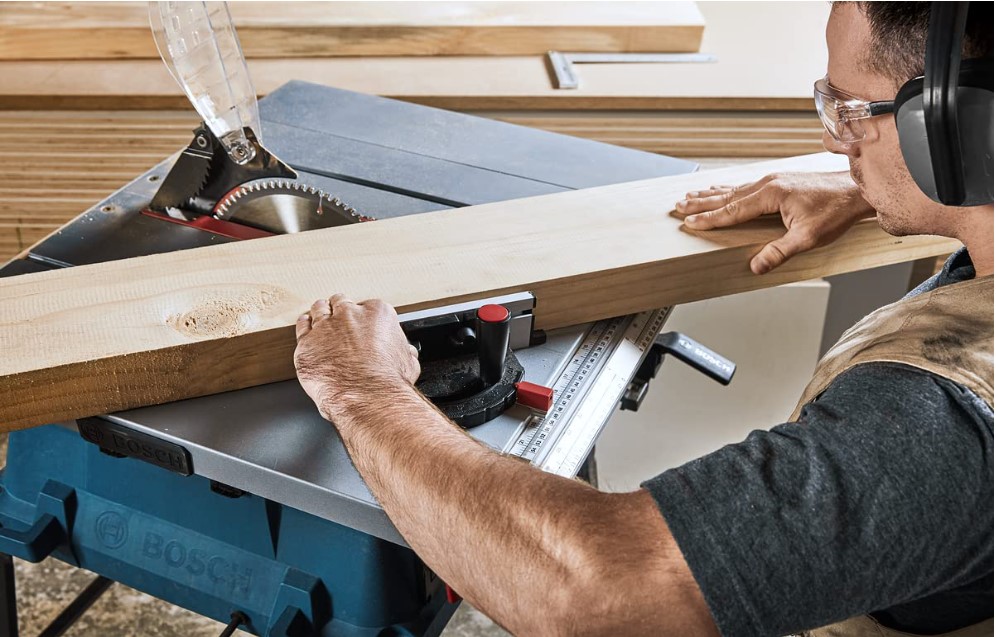
Table Saw Accessories
Table saws are versatile tools, but their capabilities can be greatly enhanced with the right accessories. Accessories like rip fences, miter gauges, push sticks, featherboards, and dust collection systems can improve accuracy, safety, and efficiency when working with a table saw.
Rip Fences: A rip fence is a crucial accessory that runs parallel to the saw blade, providing a straight edge to guide the workpiece during rip cuts. High-quality rip fences are sturdy, easily adjustable, and feature a clamping mechanism to secure them firmly in place. They help ensure straight, accurate cuts and prevent the workpiece from binding or kicking back.
Miter Gauges: A miter gauge is a guide that slides into the table saw’s miter slots, allowing you to make precise crosscuts and miter cuts at various angles. Many table saws come with a basic miter gauge, but upgrading to a high-quality aftermarket gauge can significantly improve accuracy and repeatability.
Push Sticks: Push sticks are essential safety accessories that allow you to keep your hands away from the saw blade while pushing the workpiece through the cut. They come in various designs, from simple wooden sticks to more advanced models with grip handles and built-in anti-kickback features.
Featherboards: Featherboards are adjustable guides that help hold the workpiece firmly against the rip fence or the table surface, preventing kickback and ensuring a smooth, controlled feed. They are particularly useful when working with narrow or irregularly shaped workpieces.
Dust Collection: Table saws generate a significant amount of sawdust, which can be a health hazard and make a mess in your workspace. A dust collection system, either a shop vacuum or a dedicated dust collector, can help capture the majority of the dust and debris, improving air quality and making cleanup easier.
In addition to these essential accessories, there are many other specialized jigs, sleds, and attachments available to enhance the capabilities of your table saw, such as dado blade sets, tenoning jigs, and box joint jigs. Investing in high-quality accessories can not only improve the accuracy and safety of your woodworking projects but also expand the range of tasks you can tackle with your table saw.
Table Saw Setup and Maintenance
Proper setup and maintenance are crucial for safe and efficient operation of a table saw. Before using a table saw, it’s essential to ensure that it’s correctly assembled and aligned. Misalignment can lead to inaccurate cuts, kickbacks, and potential injuries.
Setup
- Blade Alignment: The blade should be perfectly parallel to the miter gauge slots. Use a combination square or a dial indicator to check the alignment and make necessary adjustments.
- Rip Fence Alignment: The rip fence must be parallel to the blade to ensure straight cuts. Use the miter gauge slots or a straightedge to check and adjust the fence alignment.
- Blade Height: Adjust the blade height so that it protrudes about 1/4 inch above the workpiece. This minimizes the exposed blade area and reduces the risk of kickbacks.
- Splitter or Riving Knife: Ensure that the splitter or riving knife is properly installed and aligned with the blade. This device helps prevent kickbacks by keeping the kerf (cut) open.
- Blade Guard: Always use the blade guard when possible. It protects you from the spinning blade and reduces the risk of accidental contact.
Maintenance
- Lubrication: Regularly lubricate the moving parts of the table saw, such as the blade height and tilt mechanisms, according to the manufacturer’s instructions. This ensures smooth operation and prevents premature wear.
- Blade Sharpening: Keep the blade sharp for clean and accurate cuts. Dull blades can cause burning, tear-out, and increased kickback risk. Follow the manufacturer’s recommendations for blade sharpening or replacement.
- Dust Collection: Connect the table saw to a dust collection system or use a shop vacuum to minimize dust buildup. Excessive dust can interfere with the saw’s operation and create a potential health hazard.
- Troubleshooting: If you encounter issues like excessive vibration, unusual noises, or binding, stop using the saw immediately and investigate the cause. Refer to the owner’s manual or seek professional assistance if necessary.
Regular maintenance and proper setup are essential for safe and efficient table saw operation. Always follow the manufacturer’s instructions and prioritize safety when working with this powerful tool.
Table Saw Cutting Techniques
One of the primary advantages of a table saw is its versatility in making various cuts for woodworking projects. Here are some common cutting techniques you should master:
Rip Cuts
A rip cut is made parallel to the wood grain, slicing the board lengthwise. This cut is essential for resizing boards to the desired width. To make a rip cut, align the rip fence parallel to the blade and feed the board through the blade, keeping it firmly against the fence.
Cross Cuts
A cross cut is made perpendicular to the wood grain, cutting across the width of the board. This cut is commonly used for trimming boards to length. Use the miter gauge to guide the board through the blade at the desired angle, typically 90 degrees for a straight cross cut.
Dados
A dado is a trench or groove cut across the grain of the wood, often used for joining pieces together, such as in cabinetry or shelving. To make a dado cut, adjust the blade height to match the desired depth and width of the groove, and make multiple passes over the board, removing material incrementally.
Rabbets
A rabbet is a step-cut along the edge of a board, creating a recess for joining another piece of wood. This cut is commonly used in cabinetry and frame-making. To make a rabbet cut, adjust the blade height to the desired depth and use the rip fence or a dado blade to guide the board through the cut.
Box Joints
Box joints are intricate, interlocking cuts used for creating strong, decorative corners in woodworking projects like boxes or cabinets. To make box joints, you’ll need a specialized jig or sled to guide the boards through a series of precise, alternating cuts on both pieces.
Regardless of the cutting technique, always prioritize safety by using proper guards, push sticks, and featherboards to keep your hands away from the blade. Take the time to set up the saw correctly, and make test cuts on scrap wood before working on your project pieces.
Choosing the Right Table Saw
Selecting the appropriate table saw for your woodworking needs is crucial, as it can significantly impact your projects’ quality and efficiency. When choosing a table saw, consider the following factors:
Types of Table Saws
- Contractor Saws: These saws are designed for jobsite use and are more portable than cabinet saws. They typically have a lightweight construction and are mounted on an open-legged stand, making them easier to move around.
- Cabinet Saws: Cabinet saws are the most substantial and robust type of table saw, often found in professional woodworking shops. They feature a heavy, enclosed base that provides excellent stability and vibration dampening, resulting in smoother cuts and increased accuracy.
- Hybrid Saws: Hybrid saws combine the portability of contractor saws with the power and precision of cabinet saws. They typically have a cabinet-mounted trunnion system and a more robust construction than contractor saws, offering a balance between portability and performance.
Features to Consider
- Power: Look for a saw with a powerful motor, typically ranging from 1.5 to 3 horsepower, to handle tougher materials and ensure smooth cutting performance.
- Rip Capacity: Consider the maximum rip capacity, which is the distance between the blade and the rip fence. A larger rip capacity allows you to cut wider workpieces.
- Dust Collection: Efficient dust collection is essential for a clean and safe working environment. Look for saws with effective dust collection systems or ports for connecting to a shop vacuum or dust collector.
- Fence System: A high-quality fence system is crucial for accurate rip cuts. Look for a sturdy, flat, and easily adjustable fence that remains parallel to the blade.
- Miter Gauge: A precise miter gauge is necessary for accurate crosscuts and miters. Look for a gauge that glides smoothly and locks securely in place.
- Safety Features: Consider saws with safety features like blade guards, riving knives, anti-kickback pawls, and easily accessible on/off switches for added protection.
- Table Size and Extensions: A larger table surface provides better support for larger workpieces, while extensions can accommodate longer stock.
Budget
Table saws can range in price from a few hundred dollars for entry-level models to several thousand dollars for high-end professional saws. Determine your budget based on your woodworking needs and the saw’s intended usage. Remember, investing in a quality table saw can pay off in the long run with improved accuracy, efficiency, and safety.
Table Saw Alternatives
While table saws are incredibly versatile and powerful tools, they are not the only option for cutting wood and other materials. Depending on the project, workspace, and specific needs, alternative saws may be more suitable. Here are some popular alternatives to table saws:
Radial Arm Saws: These saws feature a circular blade mounted on a radial arm, allowing for cross-cutting, ripping, and miter cuts. They offer precision and versatility but require a larger footprint and can be more challenging to operate safely.
Miter Saws: Designed for precise angled cuts, miter saws are ideal for trim work, picture frames, and other projects requiring accurate miters. They come in both compound and sliding varieties, with the latter allowing for wider workpieces.
Circular Saws: Portable and lightweight, circular saws are excellent for rough cutting, framing, and on-site work. They can be used with a straightedge guide for ripping, but their depth of cut is limited compared to table saws.
Panel Saws: Also known as vertical panel saws, these saws are designed specifically for cutting large panels and sheet goods. They feature a vertically mounted blade and a sliding table, making them ideal for cabinet shops and woodworking businesses dealing with large-format materials.
Each of these alternatives has its own strengths and weaknesses, and the choice ultimately depends on the specific project requirements, workspace constraints, and personal preferences. Many woodworkers and contractors opt to have a combination of these saws in their tool arsenal to tackle a wide range of cutting tasks efficiently.
Table Saw Projects
A table saw is an incredibly versatile tool that can be used for a wide range of woodworking projects, from furniture making and cabinetry to DIY home improvements. With its precise cutting capabilities and ability to handle various materials, a table saw can help you create beautiful and functional pieces for your home or workspace.
Furniture Projects:
One of the most popular applications of a table saw is in furniture making. Whether you’re building a simple coffee table, a stunning dining room set, or a custom-designed piece, a table saw can help you achieve clean, accurate cuts and ensure a professional finish. From cutting boards to size, creating intricate joinery, or shaping decorative elements, a table saw can handle it all.
Cabinetry and Built-ins:
A table saw is essential for any cabinetry project, whether you’re building kitchen cabinets, bathroom vanities, or built-in shelving units. With its ability to make precise rip cuts and crosscuts, you can ensure that all your cabinet components fit together perfectly, resulting in a seamless and professional-looking installation.
Woodworking Projects:
For avid woodworkers, a table saw is a must-have tool in the workshop. From cutting boards and cutting boxes to creating intricate woodworking joints like mortise and tenon or dovetails, a table saw can help you tackle a wide range of projects with ease. Whether you’re working on small decorative pieces or larger-scale projects, a table saw can be your go-to tool for accurate and efficient cutting.
DIY Home Improvements:
A table saw can also be a valuable asset for DIY enthusiasts looking to tackle home improvement projects. From building custom shelving units and storage solutions to creating window frames, door frames, or even outdoor furniture, a table saw can help you achieve professional-looking results while saving you money on labor costs.
No matter what type of woodworking project you’re undertaking, a table saw can be an invaluable tool in your workshop. With proper safety precautions and a little practice, you can unleash your creativity and bring your woodworking visions to life with precision and ease.
Table Saw Brands and Reviews
Table saws are essential tools for woodworkers, carpenters, and DIY enthusiasts. With so many brands and models available, choosing the right table saw can be a daunting task. Here, we’ll explore some of the most popular table saw brands and provide insights into their product offerings, features, and customer reviews.
Popular Brands
- SawStop: Known for their innovative safety technology, SawStop table saws are equipped with a blade brake system that can detect skin contact and instantly stop the blade, preventing serious injuries. Their saws are highly regarded for their precision and durability, making them a popular choice among professionals and serious hobbyists.
- Powermatic: Powermatic is a well-respected brand in the woodworking industry, offering a range of high-quality table saws designed for both professional and home use. Their saws are known for their robust construction, smooth operation, and reliable performance.
- Delta: With a long history in the power tool industry, Delta has established itself as a trusted name in table saws. Their saws are available in various sizes and configurations, catering to different budgets and needs.
- Jet: Jet table saws are renowned for their precision engineering and sturdy build quality. They offer a wide range of models, from entry-level to industrial-grade saws, making them a popular choice among woodworkers of all skill levels.
- Grizzly: Grizzly is a brand that focuses on providing affordable yet high-quality table saws for both professional and hobbyist use. Their saws are known for their solid construction and excellent value for money.
Product Comparisons
When comparing table saws, it’s essential to consider factors such as motor power, rip capacity, fence system, dust collection, and overall build quality. Higher-end models often feature more robust construction, larger rip capacities, and advanced features like cabinet-mounted trunions and precision fence systems.
Customer Reviews
Customer reviews can provide valuable insights into the real-world performance and reliability of table saws. Many woodworkers praise SawStop for their industry-leading safety technology, while Powermatic and Jet are often commended for their precision and durability. Delta and Grizzly tend to receive positive feedback for their value and performance at various price points.
It’s important to note that individual experiences may vary, and it’s always recommended to thoroughly research and compare different models based on your specific needs and budget.
Table Saw Maintenance and Repair
Proper maintenance and timely repairs are crucial for ensuring the longevity and safe operation of your table saw. Common issues that may arise include blade alignment problems, fence issues, motor failures, and worn-out parts. Regular cleaning and lubrication can help prevent many of these problems, but eventually, parts may need to be replaced.
One of the most common parts that require replacement is the blade. Over time, even the best blades can become dull, chipped, or damaged, leading to poor cuts and potential safety hazards. Replacing the blade is a relatively straightforward process, but it’s essential to follow the manufacturer’s instructions carefully and ensure the new blade is compatible with your saw.
Another critical component that may need attention is the fence system. The fence plays a vital role in ensuring accurate cuts, and any issues with its alignment or movement can compromise the quality of your work. If the fence is damaged or not functioning correctly, it may need to be adjusted, repaired, or replaced entirely.
Regular tune-ups are also essential for maintaining your table saw’s performance. This may involve cleaning and lubricating moving parts, adjusting the blade alignment, and checking for any loose or worn components. Many woodworkers choose to perform these tune-ups themselves, but for more complex issues or if you’re uncomfortable working on the saw, it’s best to seek professional repair services.
Professional repair services can be invaluable for diagnosing and addressing more significant issues with your table saw. Experienced technicians have the knowledge and tools to properly diagnose and repair problems with the motor, drive systems, and other critical components. While professional repairs can be more expensive than DIY solutions, they can often save you money in the long run by preventing further damage and ensuring your saw operates at peak performance.
Regardless of whether you choose to perform maintenance and repairs yourself or seek professional assistance, it’s essential to follow all safety protocols and refer to your saw’s manufacturer’s instructions. Proper maintenance and timely repairs can help extend the life of your table saw and ensure it continues to provide accurate, safe, and efficient performance for years to come.
Table Saw Regulations and Standards
Table saws are powerful woodworking tools that can cause severe injuries if not used properly. To ensure safety, various organizations have established regulations and standards that manufacturers and users must follow.
One of the primary safety standards for table saws is the Underwriters Laboratories (UL) certification. UL is an independent safety certification company that tests and certifies products for safety. Table saws that meet UL’s stringent safety requirements are awarded the UL listing mark, indicating that they have been thoroughly tested and found to be safe for use when operated according to the manufacturer’s instructions.
In addition to UL certification, table saws must comply with safety standards set by organizations such as the American National Standards Institute (ANSI) and the International Organization for Standardization (ISO). These standards cover various aspects of table saw design, construction, and performance, including blade guards, anti-kickback devices, riving knives, and other safety features.
Legal requirements for table saw safety vary from country to country and even from state to state within the United States. In general, most jurisdictions require table saws to be equipped with safety features such as blade guards, anti-kickback pawls, and riving knives. Some areas may also have specific regulations regarding noise levels, dust collection, and other aspects of table saw operation.
Employers who use table saws in their workplaces must also comply with occupational safety and health regulations set by organizations like the Occupational Safety and Health Administration (OSHA) in the United States. These regulations often mandate specific safety procedures, training requirements, and personal protective equipment (PPE) for table saw operators.
Manufacturers and users of table saws must stay up-to-date with the latest safety regulations and standards to ensure compliance and minimize the risk of accidents and injuries. By adhering to these guidelines, table saws can be used safely and effectively in a variety of woodworking applications.
Future of Table Saws
The future of table saws is poised to bring exciting advancements in safety, precision, and user experience. As technology continues to evolve, we can expect to see innovative features that address common pain points and improve the overall woodworking experience.
One area of focus is enhancing safety measures. Manufacturers are exploring advanced sensor technologies and automatic blade braking systems to prevent injuries caused by accidental contact with the blade. These systems can detect when a user’s hand or body part comes too close to the blade and instantly stop its rotation, significantly reducing the risk of severe injuries.
Another trend is the integration of computer-aided design (CAD) and computer-aided manufacturing (CAM) software into table saws. This technology allows woodworkers to design and visualize their projects digitally, and then seamlessly transfer the plans to the table saw for precise cutting. Advanced software can optimize cut patterns, minimize waste, and even provide step-by-step instructions for complex projects.
The pursuit of greater precision and accuracy is also driving innovation in table saw design. Manufacturers are exploring the use of linear guides and high-precision motors to ensure smooth, consistent cuts with minimal deviation. Additionally, we may see the incorporation of laser guidance systems that project cutting lines onto the workpiece, eliminating the need for manual marking and increasing accuracy.
Portability and space-saving designs are another area of focus. As workshops and workspaces become more compact, table saws with collapsible or folding designs could become more prevalent. These space-efficient models would allow woodworkers to maximize their workspace without compromising on functionality.
Finally, the future of table saws may also involve the integration of smart technologies and connectivity features. Imagine a table saw that can connect to your smartphone or tablet, allowing you to control settings, access user manuals, and even receive real-time safety alerts or maintenance reminders.
Overall, the future of table saws promises to be an exciting blend of advanced safety features, precision cutting, user-friendly design, and seamless integration with digital technologies. As the woodworking industry continues to evolve, these innovations will undoubtedly enhance the experience for both professional and hobbyist woodworkers alike.

